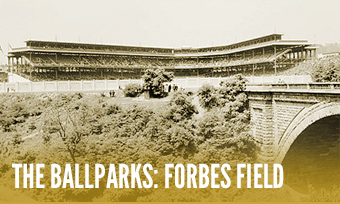THE TEAMS
Pittsburgh Pirates
Known as the Pittsburgh Alleghenys, 1882-90
THE PIRATES BY THE DECADE
The 19th Century
An original member of the American Association (born in 1882), the “Alleghenys” started slow, gained strength and became the first AA team to move to the superior National League in 1887; they fared okay until a disastrous 1890 when defections to the short-lived Players League resulted in a 23-113 record. The team quickly rebounded by pilfering players from here, there and everywhere—thus earning the name “Pirates”—but it rarely contended throughout the rest of the decade; not even Connie Mack, in an early managerial stint before his half-century of leadership with the A’s, could budge the Bucs out of the second division.
The 1900s
Profiting from a mass migration of players (including Honus Wagner, pitcher Deacon Phillippe and player-manager Fred Clarke) from the defunct Louisville Colonels after 1899, the Pirates enjoyed their most sustained run of success in franchise history, winning four National League pennants and, in 1909, their first world title. Wagner was the team’s unquestioned hitting star and a juggernaut presence in the NL, dominating almost every aspect of offense throughout the decade.
The 1910s
Playing in the palatial Forbes Field (opened in 1909), the Pirates began to fade as the stars of the 1900s aged and the roster turnover yielded a weaker lot, despite the emergence of speedy Max Carey (the most effective stolen base artist of his time) and tenacious pitcher Babe Adams; the nadir was reached in 1917 with 103 losses before a rebound began taking place. A singular sequence of history was achieved in 1912 when the Bucs hit a major league-record 126 triples—with Chief Wilson contributing an all-time individual mark of 36.
The 1920s
The Pirates returned to prominence as they constantly remained above the .500 mark, but numerous internal squabbles in mid-decade ruined any chance that the team could achieve a dynastic position in the NL. A bruising line-drive offense collectively hit over .300 five times—each everyday player on the 1925 team hit over .300 except Eddie Moore, who hit .298—and was led by great talents in Paul Waner, Kiki Cuyler and Pie Traynor. Pittsburgh won one World Series in 1925 with a thrilling seven-game classic against Washington, but two years later fell well short against the mighty 1927 New York Yankees.
The 1930s
It was a decade of lost opportunity for the Pirates, who remained competitive but never took home a NL pennant, three times finishing within five games of first place; the one that hurt the most was a 1938 campaign in which the Bucs blew a 6.5-game lead at the end of August. Hitting remained the team’s strength, as Waner continued to pound away at doubles and triples while joined by equally gifted shortstop Arky Vaughan. The lack of a consistent, solid pitching rotation proved to be the team’s Achilles heel.
The 1940s
The Pirates were hit-or-miss through the war years and hosted one of the decade’s more intriguing players in multiple 20-game winner Rip Sewell, who perfected a high-arcing “eephus” pitch that frustrated hitters and umpires alike. A postwar descent in the standings was made tolerable with the arrival of power hitter Ralph Kiner, who led or co-led the NL in home runs over each of his seven full years with the club while bringing in gate receipts for the team’s owners, which included Hollywood crooner Bing Crosby.
The 1950s
Branch Rickey, coming off groundbreaking successes in St. Louis and Brooklyn, was brought in to rebuild the Pirates. The results were disastrous at first, with the Bucs losing 100-plus games over three straight years (1952-54)—but slowly, the seeds planted by Rickey would gradually sprout a strong future roster that included pitchers Bob Friend and Vern Law, slick-fielding second baseman Bill Mazeroski and outfielder Roberto Clemente, a Puerto Rican native with amazing potential that wouldn’t be realized until the 1960s.
The 1960s
The decade began with a memorable bang as the young Pirates of the 1950s grew together, took the NL flag and shocked the favored Yankees with great clutch theatrics in the 1960 World Series, with Mazeroski’s walk-off Game Seven homer recalled as one of the game’s greatest moments. Through the rest of the decade, the Pirates continually challenged but never took another pennant, despite four batting titles from a fully evolved Clemente.
The 1970s
Another run of winning seasons took hold as the Pirates suffered just one below-.500 finish (in 1973, the one year the NL East was ripe for the taking), upgrading to modern times with a move to multi-purpose, artificially turfed Three Rivers Stadium and a switch to ornate double-knit uniforms. Led by father figure Willie Stargell, thundering MVP-caliber slugger Dave Parker and a trusty if often no-name pitching staff, the Pirates won six divisional titles and won both of their trips to the World Series, each time coming from two games down to defeat Baltimore.
The 1980s
The Pirates’ Mojo completely disintegrated by mid-decade from a drug scandal that rocked the club and led to a local trial in which six Pittsburgh residents (including the guy in the Pirates’ mascot suit) were implicated and/or convicted of distributing cocaine to players. The case crashed the Bucs’ momentum on the field, bottoming out with 104 losses in 1985. From those ashes, the Pirates began a long but impressive journey back towards winning form behind no-nonsense manager Jim Leyland and a collection of promising new talent including outfielders Barry Bonds, Bobby Bonilla, Andy Van Slyke and pitcher Doug Drabek.
The 1990s
Led by a surging Bonds (with MVPs in 1990 and 1992), the Pirates won three straight NL East titles to open the decade—but failed to advance to the World Series each time, suffering heartbreaking defeats in the NLCS. Afterward, the Pirates roster was depleted overnight—with many of its star players (including Bonds, who left for San Francisco) chasing the free agent market to richer pastures. What remained slumbered through the rest of the decade to diminishing returns both in the standings and at the box office as small-market—and small-minded—Pirates ownership did little to refresh.
The 2000s
The Pirates insisted that a new ballpark was their only way to regain a competitive edge; they built it and the fans came, but the product remained lousy as the Bucs set a North American pro sports record for consecutive straight losing seasons despite one of the most beautiful venues in the country in PNC Park—and all that revenue that flowed to the Pirates’ coffers. The team feverishly attempted to build from within, relying on maturing prospects over shelling out big bucks for free agents.
The 2010s
The depression continued until 2013 when—finally, after 20 losing seasons—the Pirates not only eclipsed .500 but made the postseason for the first of three straight years thanks to a talented young roster fronted by potent outfielder Andrew McCutchen (2013 NL MVP), speedy Starling Marte and a rare Pirates ace in Gerrit Cole. But a deeper postseason existence proved difficult for the Bucs; soon after, the window of opportunity closed as the Bucs reverted back to subpar territory, hastened by the trading of McCutchen and Cole.
The 2020s
The state of the Pirates went from bad to worse, bottoming out through the decade’s first three years with a low-budget, no-name roster that featured not one single starting pitcher winning more than five games in either season; predictably, they struggled through consecutive 100-loss campaigns in 2021-22. The latest youth movement offers some hope with big, strong shortstop Oneil Cruz and potential ace Paul Skenes.
Highlights of the Pirates’ History on This Great Game:
 1903: The First World Series The Pirates participate in the first “world’s championship” between the winners of the National and American Leagues after the two circuits agree to peacefully co-exist.
1903: The First World Series The Pirates participate in the first “world’s championship” between the winners of the National and American Leagues after the two circuits agree to peacefully co-exist.
 1909: Three-Beat Sudden ace Babe Adams of the Pirates stifles the Detroit Tigers into their third straight World Series loss.
1909: Three-Beat Sudden ace Babe Adams of the Pirates stifles the Detroit Tigers into their third straight World Series loss.
 1925: An Intestinal Excess The Washington Senators sneak by the New York Yankees, weakened by an ill Babe Ruth for a good chunk of the year—but run into the Pirates at World Series time.
1925: An Intestinal Excess The Washington Senators sneak by the New York Yankees, weakened by an ill Babe Ruth for a good chunk of the year—but run into the Pirates at World Series time.
 1960: A-Maz-ing! The Pirates become one of the game’s unlikeliest champions with a historic walk-off home run by Bill Mazeroski.
1960: A-Maz-ing! The Pirates become one of the game’s unlikeliest champions with a historic walk-off home run by Bill Mazeroski.
 1971: Dynasty on the Rise Led by a gracefully aging Roberto Clemente, the Pirates lose the first two World Series games against Baltimore before putting on a championship comeback.
1971: Dynasty on the Rise Led by a gracefully aging Roberto Clemente, the Pirates lose the first two World Series games against Baltimore before putting on a championship comeback.
 1979: One for Pops and His Family After years of injury and career decline, Willie Stargell comes alive at 39 to lift the Pirates.
1979: One for Pops and His Family After years of injury and career decline, Willie Stargell comes alive at 39 to lift the Pirates.






